 |
|
|
 |
|
|
Popular topics on this page:
Mars photographs - throughout the page; just scroll down...
Rotation of Mars in one hour
Green square in "read only" checkbox when folder is not read-only
Nikon D70s versus Canon Digital Rebel impressions
FSSM32.EXE goes to 99% CPU
Roaming user profiles are not deleted from cache
Windows desktop background picture is lost when roaming user logs off
Weather on another planet (dust storm in Chryse on Mars)
Who needs an autoguider? (webcam autoguiding)
How Dr. Bernanke will run the Fed (inflation targeting)
HP (Agilent) 33120A function generator gives 2× indicated voltage
Scroll down or press Ctrl-F to find others.

|
2005
October
31
|
Mars again

I hope you're not tired of these yet; my technique is improving and
I keep getting better and better pictures. Here is Mars around 11:15 (EST) last night.
The dark feature that looks like India is called Syrtis Major.
Maps of Mars are available
here
and
here.
Like my pictures, but unlike other maps, these have
south up – an old astronomical tradition,
because telescopes invert the image – but some maps have north up.
The features that I photograph are called albedo features and are variations
in the darkness of the sand. Craters and mountains are not normally directly
visible from Earth.
Permanent link to this entry

|
 |
2005
October
30
|
It's HAL, not HOL
It's time for my
annual reminder
that the first syllable of Halloween
is spelled with an A and
rhymes with pal, not Paul.
If you call it Holloween, you have an excessively small vocabulary
(missing the word hallow 'make holy'),
or else you've been hanging around
Stevie Wonder
too long.
(That mispronunciation kept me from wholeheartedly liking one of the most memorable
songs from our newlywed days. Has anyone made a CD of it with the word pronounced correctly?)
A quick look at Google shows that a lot of people are even
SPELLING it Holloween. Horrors!
Permanent link to this entry
As the worlds turn

This is a copyrighted image. Please contact me for permission
to republish it.
Also see my image of the
rotation of Jupiter in one hour.
I should explain something about this Martian dust storm,
which is near longitude 0 (the prime meridian) on Mars.
Mars and the earth rotate at almost the same speed.
And naturally you can only see Mars when your part of the earth
is turned toward it.
As a result,
different sides of the earth see different sides of Mars,
and the cycle repeats from day to day, shifting slowly so that it
takes about a week for new regions to drift into view.
Right now, neither Europe nor the U.S. east coast is well placed
for viewing the dust storm.
The west coast is better; Hawaii is ideally placed.
That's why you don't see it in the pictures above – except that
in the second picture, it is just beginning to come into view on the right.
That is also why
amateur planet observing
– which is of great
scientific value — needs to be an international endeavor.
Permanent link to this entry
Investment opportunity
Tomorrow, October 31, is a very good day to
buy a Series I savings bond
and probably get over 6% interest on your money for a few months,
with subsequent rates always guaranteed to be above the
inflation rate.
Click on the link for the full story. The basics are as follows:
Series I bonds pay interest at the sum of two rates, the fixed part
(which is constant for the life of the bond) and the variable part
(which is set every 6 months to match the CPI inflation rate).
The variable part will be reset on November 1 and will probably go
very high (over 5%) because the CPI includes energy costs that were
temporarily driven up by Hurricane Katrina.
When the variable part rises, the fixed part usually decreases.
But if you buy on October 31, you can lock in the current
fixed rate (1.2%) for the life of the bond.
Then, the very next day, the variable part will go up and
you'll be collecting higher interest than has been possible for years.
The minimum investment is just $25.
All I ask is that when you go to the bank tomorrow,
don't get in line ahead of me!
Permanent link to this entry

|
 |
2005
October
29
|
Not a very good view

|
|
Last night's view of Mars (around 1:30 a.m. EDT) was fairly miserable;
the air was very turbulent and I was dodging clouds.
The famous dust storm is on the right-hand edge of the visible
face of the planet
and is responsible for some of the brightness there.
That edge is also in sunlight, and the left edge isn't.
|
I left out part of yesterday's entry (the moral of the story),
which I've now put in.
You're invited to scroll down and read it...
Permanent link to this entry

|
 |
2005
October
28
|
Twice the voltage, whether you want it or not
HP (Agilent) 33120A function generator gives 2× indicated voltage
 Wednesday's mystery from
the
Engineering Labs has to do with an
HP 33120A (Agilent 33120A)
function generator that delivered twice the indicated output voltage.
Wednesday's mystery from
the
Engineering Labs has to do with an
HP 33120A (Agilent 33120A)
function generator that delivered twice the indicated output voltage.
I needed a logic-level square wave of accurately known frequency to feed into a microcontroller.
I set the 33120A to square wave, 4.8 volts amplitude, 2.4 volts positive offset.
Then, thank goodness, I decided to check it with an oscilloscope.
It was 9.6 volts with +4.8 V offset! It might have damaged the microcontroller.
Further investigation showed that all indicated voltages were a factor of 2 too high.
And the same was true of several other 33120As in the room.
Mystery solved:
The solution was that, deep within the menus of the 33120A, there's a setting for whether
the output drives a 50-ohm load or not.
In high-frequency circuits, it's common to put a 50-ohm resistor at the far end of the cable,
to minimize distortion from the cable itself.
The output impedance of the 33120A is also 50 ohms.
The resistor, if it's there, cuts the voltage in half.
The 33120A doesn't know whether the resistor is present.
You have to tell it.
That setting is deep under SYS MENU, which you get to by pressing Shift, Menu, and twirling the knob,
then pressing the down arrow to get to the cable termination setting.
Once you set the output to HIGH Z, press Enter and the setting will be remembers.
The moral of the story: Important settings that affect the performance of an instrument,
and can even damage other equipment or experiments, should not be hidden deep within menus.
At minimum, there should have been a label on the front panel saying something
like "Select 50Ω or High-Z in SYS MENU."
Otherwise we have no way to know that feature is even there.
Permanent link to this entry
More Mars dust
There's
another dust storm on Mars,
or maybe the existing one has drifted,
located just west of Sinus Meridiani.
Pictures here soon, I hope.
Currently, this part of Mars is best seen from Earth around 3 a.m. EDT each night
(Mars' rotation period being similar to our own).
Current updates are on
spaceweather.com but
the content of the site changes daily.
Permanent link to this entry

|
 |
2005
October
27
|
Mars with a new lens
 Mars is still up there, and I think this is my best picture of it yet, though
not equal to what other amateurs are getting with slightly larger telescopes.
Mars is still up there, and I think this is my best picture of it yet, though
not equal to what other amateurs are getting with slightly larger telescopes.
This was taken with an 8-inch Meade LX200 telescope, a
modified webcam
(in my case an older ToUCam 740 Pro),
an infrared blocking filter,
and, between camera and telescope, my new
Meade Series 5000 3× TeleXtender,
which is a fancy 4-element Barlow lens.
This TeleXtender is a very new Meade product and I haven't been able to find any reviews of it,
but it works very well with my f/10 telescope.
(Performance with an f/4 or f/5 telescope is something I can't easily test.)
A nice surprise was the way the lens caps are constructed; they're big enough
that they won't get lost.
The technique, as usual, was to record about 3000 frames of video, then use
Registax (free software)
to select, stack, and sharpen the best frames.
In this case, the air was quite steady, and over 2000 of the 3000 frames were used.
Permanent link to this entry

|
 |
2005
October
26
|
How Dr. Bernanke will run the Fed
I'm reading Bernanke's book on
inflation targeting.
Some key points:
- Monetary policy needs a nominal anchor, a stated goal to which everyone can compare
the Fed's actual performance, so there's no guessing.
- The inflation rate is the only suitable nominal anchor, because inflation is, in the long run,
the only thing monetary policy can control.
- When the Fed tries to pump up business by raising the money supply – as it did many
times in the 1960s and 1970s – the business boost is short-lived but the inflation persists.
Soon, the public begins to realize how the game is being played, and then inflation
becomes really entrenched.
- Theoretically, any inflation rate is OK as long as it's predictable, because interest rates
will adjust. In practice, though, a high inflation rate makes the rich richer and the poor poorer,
because the "little guy" doesn't have access to investments that protect him from inflation.
(I find it amusing that left-wing politicians have often been
in favor of inflation as if it were a way of liquidating the rich. The rich are exactly who
it doesn't liquidate.)
- Another reason to keep the inflation rate low is so that everybody will not be burdened
with calculations and special financial arrangements over the short term.
Socking your money away in a jar for 50 years
is not a good idea, but for one year it ought to be OK.
- The Consumer Price Index (CPI) tends to read high; it rises more than the real cost of living
because it doesn't reflect the way people shift their spending so that they buy different goods
as the relative prices change. For example, as a society, we've decided to have a lot more
electronic communication, and less fancy clothing, than in the 1960s.
A CPI inflation rate as high as 2% might indicate no real rise in the cost of living.
- The inflation rate should not go too low, because then it might go negative, which is disastrous
for debtors (whose ability to pay is eroded) and retailers (whose profits evaporate as the merchandise
sits on the shelves).
- Also, to prevent unemployment, it is much better to have workers receive small inflationary
pay raises every year, which can be omitted in hard times, than to have workers face pay cuts or
layoffs every time there is a slight recession.
So if Dr. Bernanke does his job right, we'll have a CPI inflation rate of about 2.5% for the foreseeable future.
Permanent link to this entry

|
 |
2005
October
24-25
|
The Bernanke era
Time out from astronomy to congratulate a native of Georgia,
Dr. Ben Bernanke, who has been nominated to
succeed Alan Greenspan as head of the Federal Reserve.
Well, he was born in Georgia...then grew up in
South Carolina, went to Harvard and M.I.T... But Georgia
will proudly claim him.
I'm no economist, but I do have some interest in monetary policy,
partly because I watched the beginning of the current era with
Volcker (1979) and then Greenspan.
They were the first to realize that controlling inflation is why
we control the money supply.
Beforehand, the government had often increased the money supply
to "stimulate business" (some businesses, not all!) and then
wondered where the inflation came from.
Bernanke is the author of a couple of interesting books,
one on
inflation targeting
(closed-loop regulation of the money supply to achieve a specified, low inflation rate)
and one on
the Great Depression.
He's a clear writer and is big on international comparative studies.
Links to some of his recent speeches are
here,
here,
and
here.
Permanent link to this entry

|
 |
2005
October
23
|
Who needs an autoguider?
As you probably know if you're reading this, astronomers photograph faint objects
by making long exposures on film or a digital sensor.
For this to work, the telescope must stay perfectly aimed at the object while
the earth rotates beneath it.
As you also know, telescopes have motors to do this.
But no motor is perfect.
When the tolerance is something like 1/2000 of a degree, no gear train in the world
is smooth enough to give perfect tracking.
Nor is the axis of rotation going to be aligned perfectly with that of the earth.
Until a few years ago, that meant we had to guide by hand while making
an exposure, watching a star through crosshairs and pressing buttons every time
it drifted off.
Now we use autoguiders, which use electronic image sensors to watch the
star and keep the telescope centered on it.
My autoguider is an
SBIG STV Deluxe
which cost almost as much as my telescope.
But it may be obsolete.
As you also know, I've been photographing Mars
through a
modified webcam
that cost less than $100.
Well... this modified webcam can also see stars if they're not too dim.
And the star on which we guide can be relatively bright even
if what we're photographing is much dimmer, as long as it's in
the same general area of the sky.
The telescope and camera don't have to aim at exactly the same object.
Now I can autoguide with any video imaging device (modified webcam, Meade Lunar-Planetary Imager,
Celestron NexImage, etc.) using
GuideDog software
(free download).
The video imager connects to a laptop which, in turn, connects to the telescope
either through its serial port or through a
standard 6-pin autoguider connector
(which includes many Celestron and Meade telescopes even if not computerized).
For the latter, one needs
a cable from
Shoestring Astronomy.
With an electrically unmodified ToUCam Pro and an 8-inch telescope, I can guide on stars down to at least
magnitude 7.5.
I'll keep using the STV out of respect for its rugged construction and high price...at least for a while.
And it does see fainter stars – but so would a better webcam.
Permanent link to this entry
Notes from all over

Martian dust storm continues:
Here's last night's catch. The air (on earth) was less steady than before,
but as you can see, the dust storm seems to have turned into a long streak.
The swirly-streaky appearance of this picture is partly due to the image processing algorithm,
which strongly favors details of a particular size rather than things that are larger or smaller.
Photographic anachronism of the day:
Some clever machinist is making adapters to
put
Exakta lenses on Canon EOS camera bodies.
Well... "whatever floats your boat" as they say.
The Exakta was one of the first 35-mm SLRs; it had an impressive set of features
but also had a reputation for being unreliable and not user-friendly.
Most Exakta lenses weren't very good.
But at least they can live on, attached to our Digital Rebels.
What makes me sad is that, as film dies out, the world is about to be full
of fine camera bodies that can no longer be used.
Bush not a conservative? There's an important strand in current American political
thought which holds that, although President Bush has taken the conservative side on a few
moral and judicial issues, he is
not
a conservative in the usual sense of the word.
Where is the fiscal restraint or the reluctance to go to war?
New-generation credit card:
Citibank has come out with a
new
type of credit card
with no late fees if you miss a payment
but are still using the card. This is apparently to accommodate the unreliability of e-mail
and online banking, as well as the occasional fit of absent-mindedness.
Also, the APR is just 9.99%, and there's a 0% promotion.
At least until you miss a payment! That's the catch. They waive the late fee, but they
charge you much higher interest (they don't say how high) from then on, for months or years.
Federal regulators are starting to make noise about the way credit card issuers make too much money
from penalties (whether late fees or punitive interest rates) rather than from normal use by normal
customers. Eliminating the late fee may be part of that.
But I still don't trust them.
Permanent link to this entry

|
 |
2005
October
22
|
Animated GIFs
Permanent link to this entry

|
2005
October
21
|
Mars, continued


As you can see, the dust storm on Mars is continuing. These two pictures were taken
four minutes apart and should look just alike, but one came out sharper than the other
due to changing atmospheric conditions on Earth.
Each was taken with an 8-inch Meade LX200, 2x Barlow lens giving f/20, Philips ToUCam Pro,
K3CCD Tools, and Registax.
Permanent link to this entry

|
 |
2005
October
20
|
The weather on another planet
Here's last night's catch. Again, because Mars' rotation period is about 24 hours,
you're looking at roughly the same features on it.
Note the
dust storm
indicated by following the two red lines.
It's an oblong yellowish patch consisting of Martian desert sand blown into the air.

At the top you see the south polar cap; at the bottom,
some white clouds.
This is the first of this season's Mars pictures
where I think I have my equipment tuned up and working
properly. It's at a slightly lower magnification (before "drizzling")
than the others because I've
eliminated a wobbly extension tube.
This image is a stack of the best 1,941 frames of a 3,094-frame video.
Naturally, cloudy weather is coming.
Permanent link to this entry

|
 |
2005
October
19
|
Victims of their own success
Two news items from the world of cyberspace.
First,
illegal
peer-to-peer file sharing is being killed off by spam and adware.
For some time, hobbyists (?)
have been setting up huge, secret peer-to-peer systems for sharing pirated
movies, songs, and the like.
You request files, and they are eventually sent to you,
you know not from where.
But since everybody's anonymous, it's easy to poison the system.
People are setting up servers that offer anything but give
you spam, adware, and viruses.
Nobody can complain, because the whole system was intended to be illegal in the first place.
Meanwhile,
Facebook
is unpopular with sororities and fraternities
because it removes the secrecy of the process of joining.
Nobody foresaw this.
Facebook
is an online social network for students.
It's mostly known as a quick way of getting a lot of spam;
publish your e-mail address, and ten million of your closest friends
will immediately write back.
Five million of whom are selling misspelled pharmaceuticals
or Nigerian banking scams.
But the new problem is that with Facebook, people can easily and quickly
find out which sororities or fraternities have accepted their friends.
The suspense of "rush" is gone.
I didn't know enough about sororities or fraternities
to realize this would be significant.
But, as I've said before, I have moral qualms about exclusive secret societies.
There's nothing wrong with friends banding together — but
I think the borders of a group of friends should always be fuzzy.
When people take votes and deliberately blackball some of
their peers, I think they've crossed the line into malevolence.
It is probably no accident that Greek-letter societies are the last stronghold
of racial segregation. They also tend to be expensive and snobbish.
Permanent link to this entry
Yet more Mars
 Here's last night's Mars image. Conditions looked good - that is, I thought
I was photographing through steady air - but Registax had a little trouble with
the alignment, so although I have a detailed image, it looks as if there may
have been a few frames that didn't get aligned properly.
Here's last night's Mars image. Conditions looked good - that is, I thought
I was photographing through steady air - but Registax had a little trouble with
the alignment, so although I have a detailed image, it looks as if there may
have been a few frames that didn't get aligned properly.
This is a stack of the best 550 of 2,544 video frames. The digital image
processing is somewhat less heavy-handed than last time.
Permanent link to this entry

|
 |
2005
October
18
|
More Mars
This picture was taken about 24 hours later than the previous one, showing
Mars from nearly the same angle (since Mars' rotation period is about the
same as ours).
It's bigger because it was "drizzled," expanded to interpolate between the pixels.

Permanent link to this entry

|
 |
2005
October
17
|
Mars
 For the next few weeks,
Mars will be
passing unusually close to the earth
and I'll be photographing it frequently.
For the next few weeks,
Mars will be
passing unusually close to the earth
and I'll be photographing it frequently.
What you see here was taken about 12:45 a.m. this morning.
I recorded 2,104 frames of video with an 8-inch telescope and a Philips ToUCam,
then used software to select, stack, and sharpen the 1,263 best frames.
But if you want to see a
really mind-boggling amateur Mars image,
click here.
Larry Owens, of the Atlanta Astronomy Club,
has managed to get a picture that actually shows topography
(mountains and canyons), using a 14-inch telescope.
It may be the best earth-based image of Mars
I've ever seen.
Permanent link to this entry

|
 |
2005
October
16
|
Nikon D70s versus Canon Digital Rebel impressions
 I've concluded my tests of the Nikon D70s for astrophotography and have
reported the results to Nikon.
Whether they'll be published more widely, I'm not sure, but
the bottom line is that there were no surprises.
I've concluded my tests of the Nikon D70s for astrophotography and have
reported the results to Nikon.
Whether they'll be published more widely, I'm not sure, but
the bottom line is that there were no surprises.
I found very much what
Christian Buil found,
namely that, for astrophotography,
the Canon has the edge.
My tests were a little more rigorous than his because I used
the same lenses on both cameras, and to ensure perfect focus,
I took each picture many times, varying the focus in tiny increments,
then kept the sharpest pictures.
Conclusions:
- The Nikon has to be used in "mode 3" to keep it from
eating star images.
Mode 3 means you turn noise reduction on, then power off
the camera while it is taking the dark frame after each
picture. That forces it to save the "truly raw" image that
had been written to the memory card temporarily.
- The Canon has slightly greater sensitivity to hydrogen nebulae,
although neither camera is very sensitive to them; film (such as Ektachrome E200)
does much better.
- The Nikon has a slightly streaky background
(near maximum black) which is not cured by
dark frame subtraction, although some type of flat-fielding might take
care of it. The Canon has a much smoother background.
In fairness to Nikon, astrophotography is not what this camera was made for.
I hasten to add that for daytime photography, it's great and I'm going to miss it.
Permanent link to this entry
Can't get away with anything
The campus newspaper reports a sterling example
of how to get caught, if you're a burglar.
Quoting from
their article:
|
In the movies, crime suspects usually try to hide from police.
In Athens Thursday morning, however, two men flagged down officers and asked for directions while holding a step ladder and a pry bar.
University Police arrested Rodney Gardy Shepard and Nathaniel Snowton on charges of burglary and possession of tools for the commission of a crime.
According to a University Police report: Police responded to a suspicious persons complaint at the Driftmier Agricultural Engineering Center at 11:55 p.m. Wednesday.
Shepard and Snowton flagged down the officers on College Station Road at Agriculture Drive. They told the officers they were lost.
One officer noticed that Snowton was carrying a step ladder, some compact discs, a roll of trash bags and a pry bar. The other officer found a broken window at the Driftmier Center.
Shepard and Snowton were arrested and transported to Athens-Clarke County jail, where as of press time, they were being held without bond.
|
Permanent link to this entry
Can't take a joke?
Earlier this week, our students came to school one morning to find parts of the campus
plastered with posters saying, "wear jeans in support of gays and lesbians" or
words to that effect. (I didn't see the posters.)
They were all taken aback because the posters had been put up late at night so
that people didn't see them until they had already dressed for school.
Also, most of the Art School wears jeans all the time because anything else would be
damaged by paint.
So people weren't altogether happy about being told they were "supporting" a controversial
organization about which they knew next to nothing.
The next day, the obvious parody happened. Somebody put up posters saying to wear
skirts, dresses, shorts, or trousers to show your support for "conservatives."
Most people chuckled.
But the campus newspaper got at least
two irate letters from gay activists.
Really, folks.
The second poster wasn't making fun of homosexuality.
It was making fun of an obviously inept attempt at communication.
You don't tell people to make a political statement by putting up posters in the dead of night
telling them they're supporting you by wearing what they're already wearing.
If you do, you're going to get made fun of.
I hasten to add that the "conservatives" weren't identified and I couldn't tell if
the maker of the second poster was supporting "conservatism" or making fun of it.
I rather suspected the latter.
Permanent link to this entry

|
 |
2005
October
15
|
The case of the killer oscilloscope
On Wednesday, a microcontroller board
that we were using down in the Engineering Labs
stopped working, and may have been permanently damaged, when we connected
an oscilloscope to it. Today I found out why.
The oscilloscope was plugged into a different outlet
than the rest of the apparatus.
And the ground pins of the two outlets were 40 volts apart!
Power line ground is connected to the chassis of the oscilloscope and
thus to the ground clip on its probe.
Apparently, what happened is that I momentarily connected the ground clip
to something in the circuit that wasn't grounded.
This should have had the effect of grounding it, but instead,
it applied 40 volts of AC to a 5-volt DC circuit. Zap!
It turned out that the outlet where the oscilloscope was plugged in
had an open ground; its ground wire wasn't connected to anything.
The voltage on the ground pin, then, was whatever happened
to leak into it through all the equipment plugged into it.
Theoretically, this was 60 volts AC, but conducted through
a rather high resistance. It showed up as 40 where we measured it.
We're going to get the wiring fixed.
Permanent link to this entry
Quote for the day
If I profess with the loudest voice and clearest exposition every portion of the truth of God except precisely that little point which the world and the Devil are at that moment attacking, I am not confessing Christ, however boldly I may be professing Christ. Where the battle rages, there the loyalty of the soldier is proved, and to be steady on all the battle front besides, is merely flight and disgrace if he flinches at that point.
- Martin Luther
Permanent link to this entry

|
 |
2005
October
14
|
Signs of the times
Inadvertently funny signs seen at Lowe's yesterday:
Flooring... We stand behind it.
(The rest of us stand on top of it. It's flooring.)
Fall Ladder Event
(It may be autumn, but we still don't want our ladders to fall.)
And Cathy heard this, on the radio, as part of an ad
for gas grills:
Natural gas brings your food to life.
That's not what I want to happen to the chicken on the grill!
Permanent link to this entry

|
 |
2005
October
13
|
You say skits-, I say skizz-...
Most people pronounce the Z in schizophrenia as TS.
This is a historical accident, reflecting the way this Greek word
(with a genuine Z) entered English through German (where Z = TS).
Until recently, I thought the TS pronunciation was universal practice.
Then I started hearing Z from American schizophrenia researchers,
and I did some digging.
This will all be written up in a linguistics paper, but the bottom line
is that medical dictionaries prefer Z and general dictionaries prefer TS.
Also, in terms unrelated to psychology, such as schizocarp 'split fruit,'
almost everyone uses Z.
I've decided to adopt the Z pronunciation
of schizophrenia, at least as long as I can get
away with it.
Permanent link to this entry

|
 |
2005
October
11-12
|
Work crunch continues
Today (Wednesday, Oct. 12), two of the great forces of the universe converge:
the mid-semester pileup and the mid-week pileup.
One of the longstanding traditions of the University - at least since we converted
to the semester system - is people's desire to do all their work on Wednesdays.
("Hump day.")
Combine that with the middle of the semester, which is also a "hump," and
you get everything trying to happen at once.
That's why you won't hear much from me for a while yet. But in the meantime...
Windows feature of the day: This
elaborate query engine
called WMI that enables programs to find out about the machine and the operating system.
Things people believe that aren't so:
Bankrate's
collection of
financial urban myths, such as "you can float a check longer if you write it in red ink."
Investment idea:
An Indian
mutual fund for U.S. investors. Look at the bull market since 2003. If I were more clever I would
connect bull markets with sacred cows somehow...
Speaking of India, our prayers are with the earthquake victims in India, Pakistan, and Afghanistan.
The Third World can suffer tragedies on a scale that is hard for Americans to conceive of.
Permanent link to this entry

|
 |
2005
October
8-10
|
MANIOS MED FHEFHAKED NUMASIOI
Appearances to the contrary, I'm still alive, though very busy.
While browsing in Philip Baldi's
The Foundations
of Latin, I was reminded that:
- Alongside the familiar -āre, -ēre, -ere, and -īre
verb conjugations, there was, in preliterate times,
an -ire conjugation with short i.
That's how we get the -iō/-ere verbs such as capiō.
The infinitive ending changed to -ere because short vowels always
change to e before r, but elsewhere, the i survived.
- The odd second person plural passive ending -minī
(as in vidēminī 'you (pl.) are being seen')
is probably really a participle, the same as Greek -menoi.
Prehistorically, Latin speakers would have said
vidēminī estis 'being-seen you(pl.)-are'.
At least, that's the theory; I don't think the participial usage
is actually attested.
[Nor does Sihler, New Comparative Grammar, accept this hypothesis.
Instead, he gives a rather long derivation from a standard IE form. - M.C., 2005 Oct. 12.]
- The
Praenestine Fibula
is nowadays generally thought to be fake,
although if you Google for MANIOS MED FHEFHAKED NUMASIOI you'll
still find plenty of people who cite it as genuine.
Maybe the letters ...F...AKED... in the inscription
should have given it away.
I should explain that Manios med fhefhaked Numasioi is very preclassical Latin
for Manius me fecit Numasio, i.e., "Manius made me [the fibula] for Numerius."
Permanent link to this entry

|
 |
2005
October
6-7
|
More F-Secure shenanigans
FSSM32.EXE goes to 99% CPU
Well... after dropping back to F-Secure 5.56, I had an episode this afternoon where
my computer became extremely slow and it turned out that FSSM32.EXE was
using too many CPU cycles - first 60%, then 80%, then intermittently 99%.
FSSM32.EXE is part of F-Secure Antivirus. Apparently, it's the part that scans
every file for viruses when you open it.
And it notoriously doesn't play well with Microsoft Indexing Service or some other
Windows components and add-ons that open a lot of files.
Here's how to diagnose what's going on when you experience a computer slowdown:
- Press Ctrl-Alt-Del.
- Choose Task Manager.
- Choose the Processes tab.
- Click twice on "CPU" at the top of the column.
You're now looking at a list of running processes, sorted with the ones that are
taking the most CPU cycles at the top. If anything is taking more than about 30%,
it had better be either the system idle loop (which gets all the cycles nobody else wants)
or a computation that you know you're running.
Reportedly, my FSSM32.EXE problem is fixed by some settings that F-Secure downloads
from the University of Georgia update server (which updates F-Secure for the whole campus),
and my installation of it simply hadn't downloaded the new settings yet.
We'll see.
Permanent link to this entry
|
Work crunch
Please do not expect quick replies to e-mail, and please
understand that I do not have any free time at present.
Several big projects are in progress, and in addition,
the University is having a flurry of administrative work.
I am not a man of leisure.
|
Permanent link to this entry

|
 |
2005
October
5
|
Roaming user profiles not deleted from cache
F-Secure Antivirus is the culprit
More computer troubleshooting today...
In a Windows roaming user profile environment, each user's profile
(desktop, software settings, etc.) is stored on the server and copied
to C:\Documents and Settings when he or she logs onto a PC.
When the user logs off, the profile is copied back to the server.
The local copy, on the PC, may or may not remain.
We have chosen to delete the local copies for security reasons.
And the tip of the iceberg was when I noticed that they weren't being deleted,
even though Group Policy said to do so, and in fact the appropriate
registry setting was in place.
Worse, they weren't even being copied properly.
I changed a file on my desktop on
one computer and the changes didn't show up on another.
Microsoft provided
valuable clues in some of their documentation.
Apparently, the problem is that some software will keep files open,
or registry keys open, after you log off.
If that happens to your profile, it can't be copied to the server.
Microsoft's
Hive Cleanup utility
diagnosed the problem by writing explicit messages in the event log,
but it didn't cure it.
(Why sections of the Registry are called "hives" I do not know.)
What cured it was dropping back from version 6.00 to version 5.56 of
F-Secure Client Security,
our antivirus package.
Note well that I'm dealing with the University of Georgia's
customized versions
of F-Secure.
The culprit may well have been some setting that the University made in 6.00,
not something inherent in the version.
I want to thank AI Lab technicians
Daniel Tuohy
and
Dennis Perez
for help with this.
Permanent link to this entry

|
 |
2005
October
4
|
Windows desktop background picture is lost when roaming user logs off
Here are some notes on a problem I troubleshot yesterday.
What follows is a copy of what I wrote in the AI Center's
internal documentation.
Problem: User sets a picture as the desktop background and logs off.
Upon logging on again (even the same PC), the picture is not there.
Explanation: Windows cannot directly use .JPG images as backgrounds,
so if the image is a .JPG, it is converted to .BMP and the .BMP is stored in
Local Settings, a profile directory that does not roam.
Thus the .BMP copy is deleted upon logoff.
Workaround: Open the picture with Photoshop or any suitable graphics
program. (The standard pictures are in C:\Windows\Web.) Save a copy as a .BMP
file in My Pictures. Set your desktop background to be the copy.
Acknowledgment: This question is answered at
the University of Kent helpdesk.
Permanent link to this entry
Nonexistent camera for sale
I invite you to
Google
for "Nikon D200".
You'll get links to news sources which tell you (correctly)
that there is not yet a Nikon D200, nor any exact information
about it, although we expect Nikon to use that model number for
a digital SLR in the near future.
But you'll also see ads offering to sell you one!
When you click on them, they don't actually offer Nikon D200s,
of course. They offer other related products.

I'm in favor of electronically indexed ads, but surely they
should be honest...??? Using a computer is no excuse
for spouting nonsense. How can Amazon be having a blowout
sale on a nonexistent product?
Permanent link to this entry

|
 |
2005
October
3
|
Google and the cheaters
I'm one of many educators who are crying foul about how Google
profits from advertising pre-written term papers for students to
buy and turn in as their own work.
Google doesn't sell them, but it runs ads for people who do.
This goes on through the Google Ads system, which is a system for placing content-targeted
ads on web pages.
Examples can probably be seen
here,
here, and
here.
I say "probably" because Google is under well-deserved pressure to get rid of them.
You can contribute to the pressure by signing
this petition.
After all, Google already bans ads for a number of other things that are
legal but dangerous, such as tobacco and weapons. Why not ban these?
More generally, I would like for society to
wake up to the harm done by educational fraud.
Buying a term paper on line is not something to which a student
succumbs in a moment of weakness.
It's a deliberate fraudulent act, like writing a bad check,
hiring someone to take a test for you, lying on a resumé,
or printing a fake diploma or professional license.
The end result of buying a term paper
is a diploma that is partly fake because
the student didn't earn it.
Educational fraud is not victimless.
It's customary to say "when you cheat, you're only harming yourself."
False. You are defrauding employers when you apply for a job with a
degree that you didn't really earn.
You are also devaluing your degree and harming the people who
earned it honestly.
Curiously, there are presently no laws against educational fraud, and businesses
such as
CheatHouse
and
MonsterPapers
operate legally.
I'd like to see that changed.
(Or see a sufficiently clever lawyer find a civil liability under existing laws.)
I'm not saying it's evil to publish samples of term papers;
it can even be useful to do so.
But when the obvious intent is for students to use
them fraudulently, the sellers ought to incur some liability.
Cheating is wrong. As a teacher, I've learned that people who cheat
believe — quite falsely — that "it's expected" and "everybody does it."
So do shoplifters, and nobody tries to claim shoplifting is OK.
Permanent link to this entry
Point of cultural literacy...

This is from the Atlanta newspaper on September 9.
Their attempt at a
peace symbol
is actually a
Mercedes-Benz logo. (Yuppies!)
Nowadays it is easy to verify that the Vietnam-era peace symbol
was actually designed in 1958 as a combination of the
semaphores
for N and D (Nuclear Disarmament).
In the 1970s we were often told that it was a symbol derived
from witchcraft or other
dubious sources.
Without the Internet, it was much harder to check facts.
On the Internet, anybody can publish, but anybody else can also publish,
and that tends to work against misinformation.
There's also a logical problem:
How can a symbol "mean" anything other than what people mean by it?
Suppose a present-day political symbol did happen to match a symbol that
had been used for nefarious purposes by somebody else in the past.
Would that give it evil powers?
Wouldn't it be rather superstitious to even think that it might?
Permanent link to this entry

|
 |
2005
October
2
|
Hoovers and web tricks
|
On my first or second day as a student at Cambridge University in 1977,
one of the college maids came to my room bright and early and asked,
"Mind if I give you a hoove around?"
I had no idea what she meant.
It turned out she had brought her Hoover vacuum cleaner and
it was time to "hoove" (vacuum) my carpet.
Fast-forward to 2005.
Melody and I have just bought a
dog-owner's essential tool —
a Hoover carpet cleaner.
After carefully studying all the available products,
Melody chose the one depicted here.
It cleans the carpet by spraying detergent solution into it and immediately
vacuuming it back up.
Melody wrote a well-thought-out review of it for
Epinions, which you
can read (without joining Epinions) here.
If you click on the picture at the right, you'll see Hoover's web page
for this particular product, and if you view it with Opera, the page
will start with a lot of words apparently intended to attract search engines.
They didn't hide them quite well enough.
|
|

|
Permanent link to this entry
Notes from all over
There's a huge collection of electronic circuits
at discovercircuits.com.
In Cameroon, there are
lakes that kill people
by emitting carbon dioxide and suffocating entire villages.
This is entirely of natural origin, not man-made.
September was apparently a banner month for bad taste in advertising — both
Muslims
and
Christians
have been insulted by culturally illiterate advertisers.
(In the latter story, why do they say "Catholics"?
Jesus' crown of thorns is not a peculiarly Catholic notion.
Maybe, in the journalistic mind, Christians who care about anything are Catholics.)
I have Suze Orman's financial call-in show
on the TV across the room, as audible wallpaper.
I'm learning a lot about the younger generation — not their finances, but their way of life.
Since 100% of my descendants are one generation younger than me, this is of personal interest.
Apparently, a common practice nowadays is to graduate from college, go to work, overspend,
get deeply in debt, and then try to marry someone who will pay your bills.
Amusingly (and frighteningly), this often works out to two debtors each expecting the other
to pay off their debts. Yikes!
Permanent link to this entry

|
 |
2005
October
1
|
A red herring, or rather a green square
Windows displays a green square in the "Read Only" checkbox
when the folder is in fact not Read Only
A red herring is something that leads you off the track.
The term comes, I think, from Scottish dog training.
Well, the red herring that plagued me, as a minor
and needless complication of our very big server changeover project,
was green.
If you right-click on a folder in Windows XP and look at its properties,
you'll see something like this:

This might make you think the folder has the Read Only attribute,
i.e., you're not allowed to alter things within it.
False. If the folder were really marked Read Only, you'd see a
green checkmark:

I don't know what the green square means. (Nor the yellowish business
in the "Hidden" checkbox.) But it certainly wasted my time. I was trying to
figure out how all our folders got tagged Read Only in the process of being
copied from the other computer.
[Note added Oct. 3: See Microsoft's attempt at an explanation
here.
The green square means "you can check this and I'll set the files to be
read-only, but right now I don't know whether they're read-only or not."
Thanks to Jim Mischel for the link.]
Permanent link to this entry

|
 |


![]()




 Mars is still up there, and I think this is my best picture of it yet, though
not equal to what other amateurs are getting with slightly larger telescopes.
Mars is still up there, and I think this is my best picture of it yet, though
not equal to what other amateurs are getting with slightly larger telescopes.





 Here's last night's Mars image. Conditions looked good - that is, I thought
I was photographing through steady air - but Registax had a little trouble with
the alignment, so although I have a detailed image, it looks as if there may
have been a few frames that didn't get aligned properly.
Here's last night's Mars image. Conditions looked good - that is, I thought
I was photographing through steady air - but Registax had a little trouble with
the alignment, so although I have a detailed image, it looks as if there may
have been a few frames that didn't get aligned properly.

 For the next few weeks,
Mars will be
For the next few weeks,
Mars will be
 I've concluded my tests of the Nikon D70s for astrophotography and have
reported the results to Nikon.
Whether they'll be published more widely, I'm not sure, but
the bottom line is that there were no surprises.
I've concluded my tests of the Nikon D70s for astrophotography and have
reported the results to Nikon.
Whether they'll be published more widely, I'm not sure, but
the bottom line is that there were no surprises.




